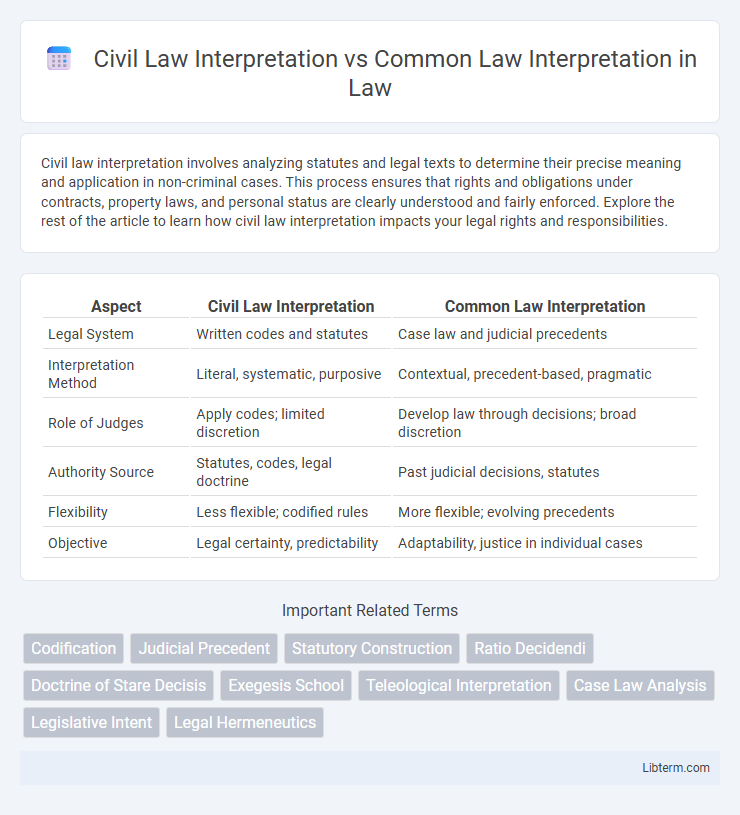Civil law interpretation involves analyzing statutes and legal texts to determine their precise meaning and application in non-criminal cases. This process ensures that rights and obligations under contracts, property laws, and personal status are clearly understood and fairly enforced. Explore the rest of the article to learn how civil law interpretation impacts your legal rights and responsibilities.
Table of Comparison
| Aspect | Civil Law Interpretation | Common Law Interpretation |
|---|---|---|
| Legal System | Written codes and statutes | Case law and judicial precedents |
| Interpretation Method | Literal, systematic, purposive | Contextual, precedent-based, pragmatic |
| Role of Judges | Apply codes; limited discretion | Develop law through decisions; broad discretion |
| Authority Source | Statutes, codes, legal doctrine | Past judicial decisions, statutes |
| Flexibility | Less flexible; codified rules | More flexible; evolving precedents |
| Objective | Legal certainty, predictability | Adaptability, justice in individual cases |
Introduction to Legal Interpretation
Civil law interpretation prioritizes codified statutes and systematic application of written codes, emphasizing the literal meaning and legislative intent within a structured framework. Common law interpretation relies heavily on judicial precedents, case law analysis, and the principle of stare decisis to adapt legal rules to evolving societal contexts. Introduction to legal interpretation in these systems highlights the contrast between deductive reasoning from general principles in civil law and inductive reasoning from past judgments in common law.
Defining Civil Law Interpretation
Civil Law interpretation primarily relies on codified statutes and legal codes, emphasizing the literal meaning of the written law as enacted by legislative authorities. Judges in Civil Law systems apply systematic and deductive reasoning to interpret statutes, often refraining from extensive reliance on precedent or case law. This method ensures consistency and predictability, grounding legal decisions firmly in the legislative framework rather than judicial discretion.
Defining Common Law Interpretation
Common law interpretation centers on judicial decisions and precedents, where judges actively interpret statutes based on previous case law, emphasizing the principle of stare decisis. Unlike civil law systems that rely heavily on codified statutes, common law interpretation allows for flexibility and adaptation through case-by-case analysis, fostering legal consistency across jurisdictions. This dynamic process ensures that legal meanings evolve with societal changes, guided by authoritative judicial rulings.
Historical Foundations of Legal Systems
Civil law interpretation traces its roots to Roman law and the comprehensive codification efforts such as the Napoleonic Code, emphasizing statute-based rules and systematic legal codes. Common law interpretation evolved from medieval English law, relying heavily on judicial precedents and case law to guide legal decision-making. These distinct historical foundations shape how civil law prioritizes codified statutes while common law emphasizes judge-made law and interpretive flexibility.
Key Principles of Civil Law Interpretation
Civil law interpretation emphasizes the literal meaning of statutory text, prioritizing the codified statutes and legal codes as primary sources for resolving disputes. Key principles include the pursuit of the legislature's intent, systematic interpretation within the legal code, and the use of general principles such as good faith and equity. Judges in civil law systems apply these methods to achieve predictable and coherent legal outcomes, contrasting with the case-based reasoning typical of common law interpretation.
Core Doctrines of Common Law Interpretation
Core doctrines of common law interpretation emphasize the principles of textualism, where the precise wording of statutes is paramount, and purposivism, which seeks to understand the legislative intent behind the text. Judges in common law systems apply precedent or stare decisis to ensure consistency and predictability in legal rulings, distinguishing it from civil law systems that prioritize codified statutes with less reliance on judicial interpretation. The doctrine of ejusdem generis and the rule of lenity are key interpretative tools within common law, helping to clarify ambiguous legal language based on established case law.
Role of Judges in Both Systems
In Civil Law systems, judges primarily apply codified statutes with limited discretion, emphasizing legal codes' intent and systematic interpretation to resolve disputes. Common Law judges play a proactive role by interpreting precedents, shaping the law through case decisions and legal reasoning within the doctrine of stare decisis. The contrast highlights Civil Law judges as implementers of written law, while Common Law judges function as law makers through judicial interpretation.
Precedent vs. Codification
Civil law interpretation relies heavily on codification, where statutes and legal codes provide comprehensive rules that judges apply directly, limiting reliance on past judicial decisions. Common law interpretation prioritizes precedent, meaning courts look to previous judicial rulings to guide the application of law, creating a dynamic and evolving legal framework. This fundamental distinction shapes legal predictability in civil law systems and adaptability in common law jurisdictions.
Impacts on Legal Certainty and Flexibility
Civil law interpretation prioritizes codified statutes and systematic application, enhancing legal certainty by providing clear, prescriptive rules that reduce ambiguity. Common law interpretation relies on judicial precedents and case-by-case analysis, offering greater flexibility to adapt to evolving societal values and unforeseen circumstances. This dynamic balance influences how legal systems address predictability in rulings versus adaptability to new challenges.
Comparative Analysis and Global Trends
Civil law interpretation relies heavily on codified statutes and systematic legal codes, emphasizing the literal meaning and intent of the legislature, whereas common law interpretation prioritizes judicial precedents and the evolving principles established through case law, allowing for greater adaptability and contextual analysis. Comparative analysis reveals that civil law systems maintain consistency and predictability through written codes, while common law systems foster flexibility and situational justice via judicial discretion, influencing how legal certainty and fairness are balanced globally. Recent global trends show a convergence where civil law jurisdictions increasingly incorporate judicial interpretations for practical adaptability, and common law systems adopt statutory reforms to enhance clarity and consistency.
Civil Law Interpretation Infographic

 libterm.com
libterm.com